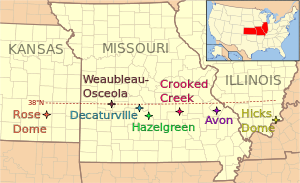Impact crater at the 38th parallel
The impact craters at the 38th parallel form a lineament of impacts or circular structures along the 38th north latitude . The line-up of these structures extends over 700 kilometers from the southeast of the US state of Illinois via Missouri to eastern Kansas .
description
The lineament begins in southeast Illinois with the Hicks Dome , which is likely to be of volcanic origin. It is followed further west by the Avon Structure in eastern Missouri, then the Crooked Creek Impact Crater in central Missouri, the Decaturville Impact Crater , the Hazelgreen Structure , the Weaubleau Osceola Structure in western Missouri and finally the Rose Dome in eastern Kansas . The Furnace Creek structure , which is also located in Missouri, is usually added to this.
location
- Hicks Dome - Illinois - 37 ° 30'N, 88 ° 24'W
- Avon Structure - Missouri - 37 ° 48'N, 90 ° 12'W
- Furnace Creek Structure - Missouri -
- Dent Branch Structure - Missouri -
- Crooked Creek Impact Crater - Missouri - 37 ° 48'N, 91 ° 24'W
- Hazelgreen Structure - Missouri - 37 ° 42'N , 92 ° 24'W
- Decaturville Impact Crater - Missouri - 37 ° 54'N, 92 ° 42'W
- Weaubleau-Osceola Structure - Missouri - 38 ° 00'N , 93 ° 36'W
- Rose Dome - Kansas - 37 ° 42'N, 95 ° 42'W
interpretation

In 1996, Rampino and Volk interpreted the lineament as the remnant of a multiple meteorite impact that is said to have occurred in the Lower Carboniferous ( Mississippian ) or the early Upper Carboniferous ( Pennsylvania ). The authors base their perspective on in 1994 to the planet Jupiter downed comet Shoemaker-Levy 9 , which had been torn before his crash into several fragments, which are then consecutively beating up the planet's surface.
The probability that such an event will take place on Earth is viewed as minimal, since the Earth's gravitational field is much smaller than that of Jupiter and therefore cannot pull a celestial body hurrying close to it to tear it gravitationally into pieces. However, it must be countered that on the moon with its weak gravitational field several impact chains can be observed one behind the other.
Not all geologists share the view of multiple impacts, as doubts persist about the age and how each structure was formed. For example, the Hicks Dome is interpreted as a volcanic structure, as its flank area is associated with passages of magmatic origin. The Hicks Dome is a structural bulge, the Devonian core of which has been raised about 1,300 meters above the surrounding layers. Other circular structures can also be associated with faults and fractures or with igneous rocks and their mineralization.
Age
The age of the Crooked Creek impact crater is limited to 320 ± 80 million years BP , the Decaturville crater is 300 million years BP. The age of the Weaubleau-Osceola structure can be given biostratigraphically as the middle Mississippian and assigned to the American stages of the latest Osageum or early Meramecium ( Viseum - 340 to 336 million years BP). No information is yet available about the age of the other structures. Overall, the impact chain is therefore very imprecisely defined in terms of time.
Conclusion
As of 2016, only two of the original eight structures had been recognized as real impact craters , the Crooked Creek Impact Crater and the Decaturville Crater. These two structures are also listed in the Earth Impact Database . Like Crooked Creek and Decaturville, the Weaubleau-Osceola structure contains planar deformation lamellae in quartz and should therefore also represent an impact crater. However, the Hazelgreen structure is very questionable. The Rose Dome, Furnace Creek Structure, and Avon Structure are believed to be the result of volcanic explosions.
Recently, the controversial impact chain has even been expanded to include two structures - Dent Branch and Silver City Dome , but both of which are likely to be of volcanic origin.
See also
Individual evidence
- ↑ Rampino, M. R and Volk, T .: Multiple impact event in the Paleozoic: Collision with a string of comets or asteroids? In: Geophys. Res. Lett. tape 23 , 1996, pp. 49-52 .
- ↑ Raymond Wiggers: Geology underfoot in Illinois . Mountain Press, 1997, ISBN 0-87842-346-X , pp. 252-256 .
- ↑ Evans, KR et al .: Re-evaluating the 38th Parallel Serial Impact Hypothesis . In: American Geophysical Union, Fall Meeting . abstract # P31A-1384, 2008.

